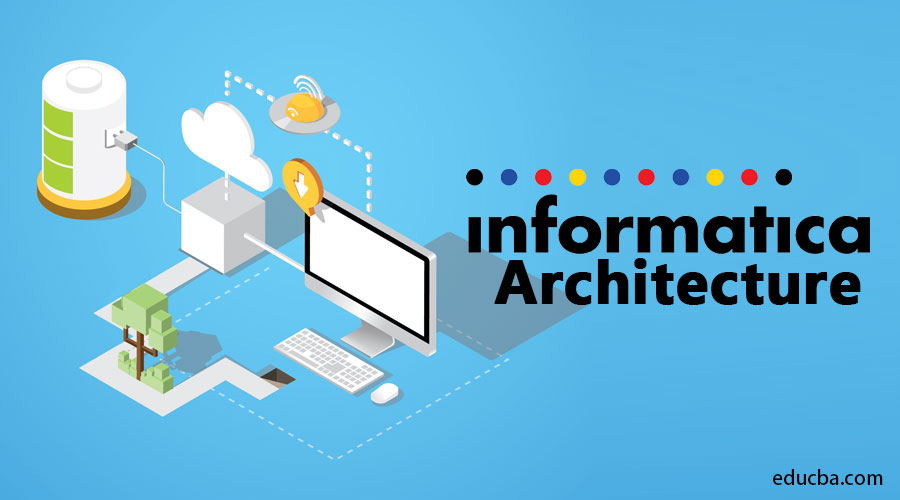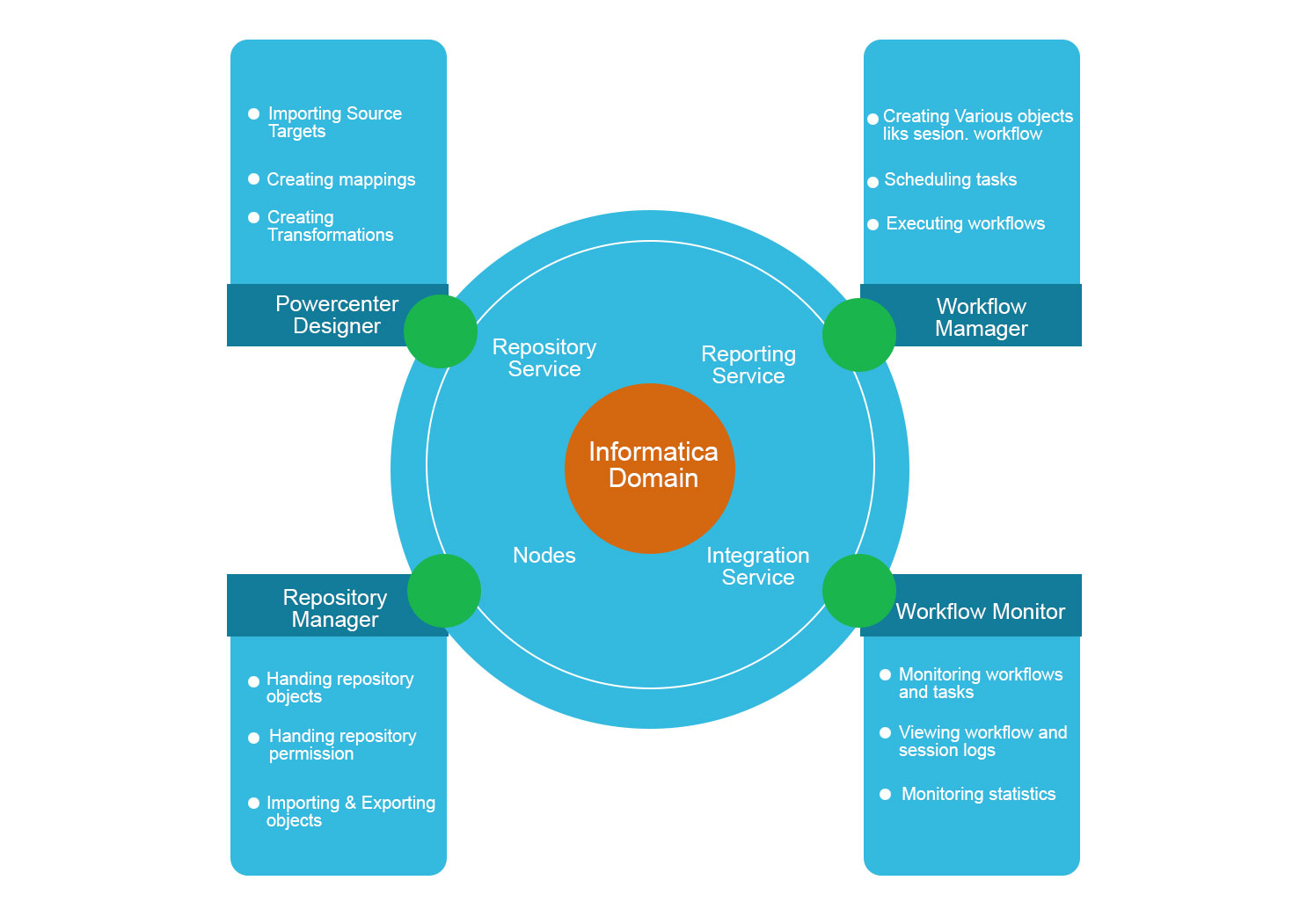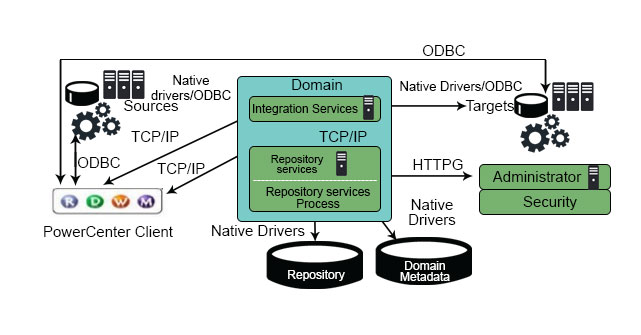Updated March 20, 2023
What is Informatica Architecture?
Informatica Architecture is comprised of multiple components or tools for ETL processing. The major ETL product release from the organization Informatica is known as the Informatica power centre. It has four components to develop, configure, process and monitor the ETL flows or mappings. The components of Informatica architecture are Powercenter Designer, Workflow Manager, Workflow Monitor, Repository Manager. Apart from these data processing tools, certain services are associated with the Informatica architecture, the services known as Integration service, repository services, nodes and reporting services. The Node is the major component in which all the other services processed to extract, transform and load the data.
The different editions of Informatica PowerCenter as available in the market are below.
- Standard edition
- Advanced edition
- Premium edition
Below are few of the typical uses of Informatica:
- Any organization migrating from previously installed Legacy systems like mainframe to any new database. The data migration from the existing system to the current system can be performed.
- Operation setting up their own data warehouse will require an ETL tool for moving the data to the warehouse from the production system.
- Informatica supports data integration from different systems like multiple databases or multiple files, which is extremely important while setting up a data warehouse.
- Informatica supports data cleansing as all the data from the production system is not needed in a data warehouse.
- Informatica is the most efficient tool offering a wide range of editions for different products among all the competitors offering ETL solutions. This helps the client to choose any edition based on the specific requirements. Informatica has also been ranked among the topmost data integration product available in the market.
The Informatica Architecture
Informatica has a service-oriented architecture consisting of the below services and components.
- Repository service: The repository service is used to maintain the metadata and provide access for the same to other services.
- Integration service: The integration service is used for the move of the data from source to target.
- Reporting service: The reporting service is used to facilitate the report generation.
- Nodes – Node is the computing platform on which the different services are executed.
- Informatica designer: The Informatica designer creates mappings showing the data flow between the source and target.
- Workflow manager: The Informatica workflow manager is used to create the workflow and other tasks and execute the same.
- Workflow monitor: The Informatica workflow monitor is used for monitoring the execution of the workflows.
- Repository manager: The Informatica repository manager is used for managing the objects in the repository.
Informatica Domain
- Informatica Architecture is service-oriented architecture.
- The Informatica domain in the Informatica tool is the fundamental administrative unit.
- It consists of nodes and services that can be divided into folders and subfolders based on the administration requirement and design architecture.
- Informatica administrator console web page creates a domain that can be created which looks like a folder. Under that folder, a node can be created along with the services.
- Inside the domain, a node acts as the logical representation of the machine. The different services and processes in the Informatica run in the node. There can be multiple nodes in a domain. A Gateway node also exists inside a domain. A Gateway node receives the request from different clients and routes them to respective services and nodes.
A domain consists of two types of services.
Type 1: Service Manager responsible for managing operations like authorization, authentication, and log in. It is also responsible for running application services on different nodes, along with managing users and groups.
Type 2: Application services consist of specific services like repository service, reporting service, and integration service. According to the configuration, the services run on respective nodes.
PowerCenter repository
- The Informatica PowerCenter repository consists database which is maintained by repository service. The metadata is stored in database tables. The Informatica client tools connected to a repository are Informatica designer, Informatica workflow monitor, Informatica workflow manager. Repository service enables these clients to access the repository.
- Repository service is a service that Informatica offers for managing a repository. The repository service handles one request exclusively for one repository and could execute on multiple nodes to increment the performance. It also offers a version control mechanism with which we can maintain the different versions of the same object and avoid multiple users modifying the same object simultaneously.
Domain configuration
The domain is the most fundamental administrative control Informatica, the parent entity composed of different services like repository service, reporting service, integration service, and different nodes. The domain configuration is configured from the Informatica admin console, a web page UI opened in a web browser. After logging in to the admin console, it shows different services like integration service, repository service, nodes, domain, etc. It also shows the status of the different services, whether they are running or not.
Power Centre connectivity
- The different PowerCenter client tools like workflow manager, designer, repository manager, and workflow manager are development tools installed on the client machine. The different mapping and objects that we create are saved in the Informatica server, and therefore the clients must have the network connectivity with the server. Moreover, the clients connect to sources and targets for importing the structure definition along with metadata. Thus, it has to maintain connectivity with the source/ target.
- The PowerCenter uses TCP/IP to connect to integration service and repository service.
- PowerCenter uses ODBC drivers to connect between source and targets.
Repository service
Repository service is responsible for maintaining the connectivity between clients and the power Centre repository. It is a multithreaded process that keeps the metadata in the repository up to date.
Integration service
Integration service is the service responsible for the execution of the tasks created in Informatica. It is a task inside the Informatica server that waits for a task to be assigned to it. As soon as a task is assigned to it, supposed to execute a workflow, the integration service fetches the details and starts the execution.
Conclusion – Informatica Architecture
Informatica is a service-oriented architecture consisting of components like application services, service Manager in the Informatica domain. It consists of application services like repository service, reporting service, and integration service. Thus, Informatica Architecture is formed on the accumulation of all these services.
Recommended Articles
This has been a guide to Informatica Architecture. Here we discuss what Informatica is? Informatica architecture, domain, and its two types. You can also go through our given articles to learn more-





